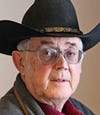It has always been easy to look back and say what one should have done. What is needed, however, is a trigger signal before the fact.
March 4, 2019
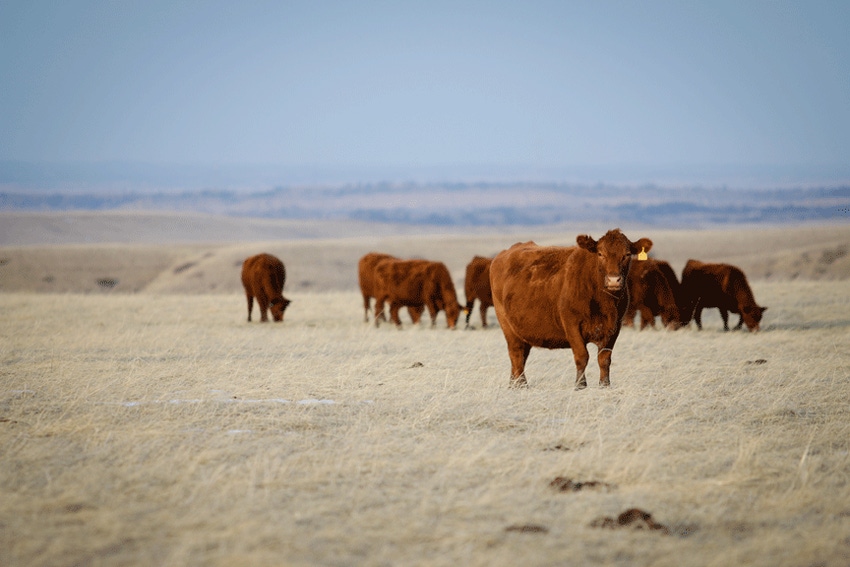
My study rancher recently raised an important question: Should he be adjusting his beef cow numbers as he goes through the cattle cycle? In the past, he had not been doing so.
In the 1980s, I observed some Wyoming cattle producers starting beef cow herds that became very successful businesses. I also observed some startup beef cow businesses that failed. Some cows were high lifetime net income-generators, and other cows were not.
I became suspicious that a key determinant of survival was the startup year in the cattle cycle. This suggested, at least to me, that during a beef price cycle, the year a cow starts calving has a major impact on the lifetime net income she generates.
Later, my Integrated Resource Management work in North Dakota with individual ranchers during the 1990s convinced me that the cattle cycle startup year was all-critical for a cow generating high lifetime net incomes during a cattle cycle.
Finding the best ones
So, how do you identify high net income-generating cows in advance? This seems to me to be a key cattle cycle question.
I would like to share with you a couple of rancher conversations I have had through the years on this subject. These two conversations planted the seeds for my current work on cattle cycles.
My first conversation goes back to the mid-1980s, when a rancher came up to me after one of my University of Wyoming Extension meeting presentations. He indicated that he bought cows every seven years or so. The purchase years were very specific and very specifically planned. This rancher shared with me the specific years that he purchased cows.
I dug out historical cattle prices and sure enough, these cows typically produced calves during the years of higher-priced calves. I concluded that these cows tended to be high net income-generators.
In the early 1990s, a Minnesota rancher came up to me again after one of my university Extension presentations and said that in a certain year, he bought 100 young cows. He also sold all calves born and did not add replacements. Now his cow herd was gone.
I immediately pulled out my overhead of calf prices, looked at it, and said, “And you made money, didn’t you?” I will never forget his reply. “I did not come up here to tell you if I made money or not. I came here to ask you when I should buy my next 100 cows.”
Computer connections
After retiring in 2000, I ran a consulting firm where I spent eight years evaluating individual ranchers’ beef cow herds, one herd at a time. I spent my spare time building computer simulation models generating detailed economic analyses of these individual beef cow herds. I created a database of all these herds, looking for profit indicators across these herds.
I closed down my consulting business in 2009, and since then have been expanding my computer models to further analyze beef cow herds and cattle cycles.
In the next decade following my retirement, (2000-08) we had BSE in 2003; two droughts — one in 2003 and another in 2006; and the ethanol era beginning in 2007, bringing on record corn prices.
These events clearly upset any resemblance of a cattle cycle in the 2000-to-2008 time period. Those eight years were a time of just surviving in the beef cow business. Nobody was thinking “cattle cycles.”
Years 2009 to present brought the cattle cycle back, regenerating my renewed emphasis on the cattle cycle. Thank goodness I had my cattle cycle experience of the 1980s and 1990s to fall back on.
The biggest problem with suggesting a strategy for taking advantage of a cattle cycle has been identifying a “management trigger signal” before the fact. It has always been easy to look back and say what one should have done. What is needed, however, is a trigger signal before the fact. I have spent considerable time researching that trigger signal.
My eastern Wyoming-western Nebraska study rancher has now asked me to help him identify that trigger signal. As background for this study, I am going to first share with my readers some of the management data compiled and presented to my study herd manager.
Winter feed costs. Figure 1 presents the calculated historical winter feed costs per cow for the study herd over the current cattle cycle (2009 through a 2019 projection).
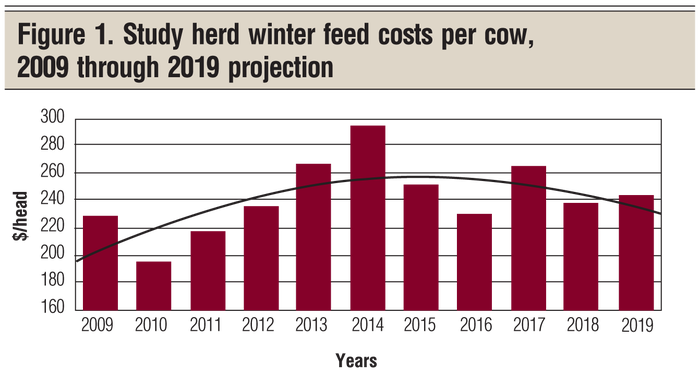
Winter feed costs trended upward in the first half of the cattle cycle, peaking in 2014. From 2014 through the 2019 projection, winter feed costs averaged $243 per cow. Winter feed costs hit a high in 2014 and went down in 2016, but are now slowly working back upward due to both hay and corn price increases.
Summer pasture costs. Figure 2 presents the summer pasture costs per cow for the study herd over the current cattle cycle (2009 through a 2019 projection). Pasture costs tend to be somewhat fixed but did certainly go up after the high calf prices in 2014. Pasture costs since 2016 have leveled off slightly, as calf prices have weakened in the last years of this cattle cycle. Pasture costs are very slow to adjust downward.
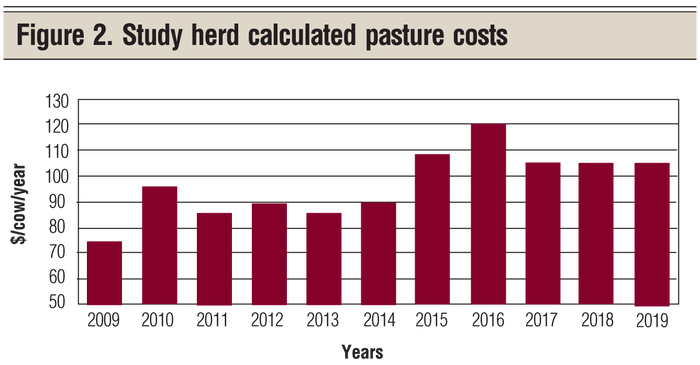
Cost of developing heifers. A significant cost of a perpetual beef cow herd is the cost of replacement animals. My study rancher raised his own replacement heifers annually during the last cattle cycle.
The actual cost of developing his weaned replacement heifers varied somewhat from year to year, depending primarily on the market price of feeds fed. Figure 3 presents the estimated postweaning cost of developing replacement heifers on my study ranch. The variation in annual development costs reflects the changing annual market value of feeds fed and changing annual grazing costs.
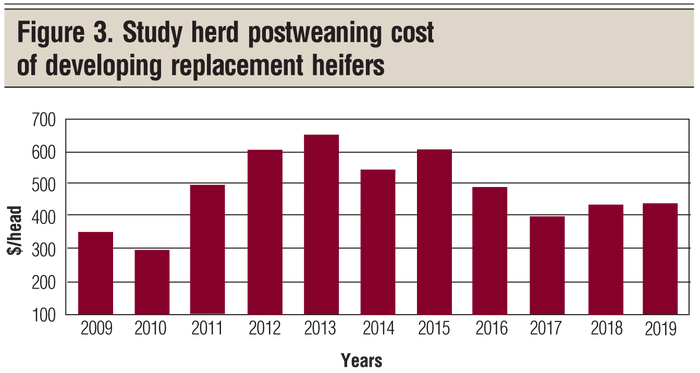
The cost of raised replacement heifers also has a second component — the market value of his raised replacement-type heifers valued on their weaning date. This is the opportunity cost of not selling the replacement-type heifers at weaning.
The accumulated capital investment in this static herd is calculated annually by the rolling seven-year average of his annual total cost of all developed heifers.
The cost of raised replacement-type heifers varied considerably over the current cattle cycle. Figure 4 presents the calculated total cost of replacement heifers (value of replacement-type heifers at weaning plus cost of development that next year). Figure 4 illustrates the year-to-year variation in the calculated cost of replacement heifers for the study ranch. Yes, it does make a difference when replacement heifers are developed.
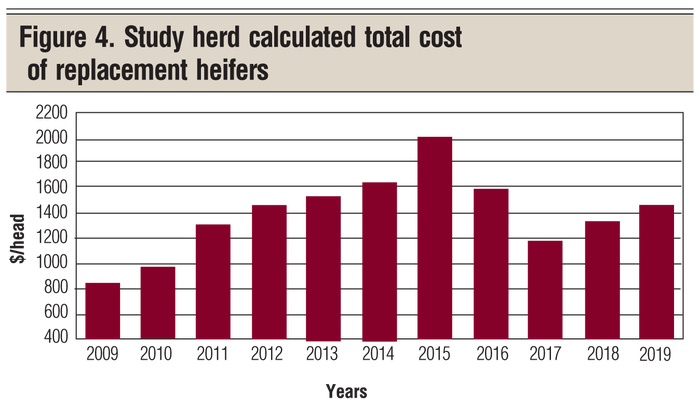
After seeing Figure 4, my study herd manager’s immediate question was, “How does my cost of raising replacement heifers compare to the cost of purchased replacement heifers?”
It was a real challenge to find good data on the purchase cost of replacement heifers over the current cattle cycle. Figure 5 presents my best effort to compile the localized purchase price of replacement heifers for my study rancher.

These two charts suggest that raising replacement heifers on this ranch appears to be a lower-cost approach to obtaining replacement heifers. How these replacement strategies and pattern actually affect the overall profitability of the ranch in a given cattle cycle will be addressed in my next article.
Stay tuned.
Hughes is a North Dakota State University professor emeritus. He lives in Kuna, Idaho. Reach him at 701-238-9607 or [email protected].
About the Author(s)
You May Also Like
